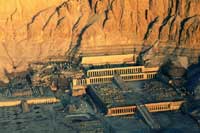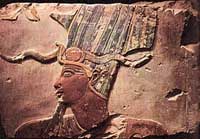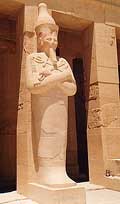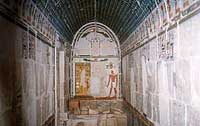|
El-Deir El-Bahari
 Lying directly across the Nile from the Great Temple of Amun at
Karnak, the rock amphitheater of Deir el-Bahri provides a
natural focal point of the west bank terrain and an inviting
site for the temples of many rulers. The natural rock
amphitheater, a deep bay in the cliffs, was an important
religious and funerary site in the Theban area. Lying directly across the Nile from the Great Temple of Amun at
Karnak, the rock amphitheater of Deir el-Bahri provides a
natural focal point of the west bank terrain and an inviting
site for the temples of many rulers. The natural rock
amphitheater, a deep bay in the cliffs, was an important
religious and funerary site in the Theban area.
The remains of the temples of Nebhepetre Mentuhotep II,
Hatshepsut, and Tutmosis III, as well as private tombs dating to
those reigns and through to the Ptolemaic period can be found
here.
The most important private tombs at Deir el-Bahri are those of
Meketra, which contain many painted wooden funerary models from
the Middle Kingdom, and even the first recorded human-headed
canopic jar, and the tomb of Senenmut, Hatshepsut’s adviser and
tutor to her daughter..
 Temple of
Nebhepetre Mentuhotep Temple of
Nebhepetre Mentuhotep
Nebhepetre Mentuhotep was the first ruler of the 11th Dynasty in
the Middle Kingdom. His temple was the first to be built in the
great bay of Deir el-Bahri.
It is smaller and not so well-preserved as is the later temple
built by Hatshepsut.
The front part of the temple was made of limestone and was
dedicated to Montu-Ra, local deity of Thebes before Amun.
The rear of the temple was made of sandstone and was the cult
center for the king.
 Temple of
Tutmosis III Temple of
Tutmosis III
Tutmosis III, the successor to Hatshepsut, built a temple
complex here. It was only discovered in 1961.
The complex was built to Amun, as was a chapel to Hathor. The
structure was probably intended to receive the barque of Amun
during the Feast of the Valley, and thus would have replaced the
temple of Hatshepsut.
After a landslide seriously damaged the temple at the end of the
20th Dynasty, it was apparently abandoned. It then became a
quarry, and later, a cemetery for the nearby Coptic monastery.
 Temple of
Hatshepsut Temple of
Hatshepsut
Hatshepsut was a woman who dared to challenge the tradition of
male kingship. She died from undisclosed causes after imposing
her will for a time. After her death, her name and memory
suffered attempted systematic obliteration.
The temple of Hatshepsut is the best-preserved of the three
complexes. Called by the people Djeser-djeseru, "sacred of
sacreds", Hatshepsut’s terraced and rock-cut temple is one of
the most impressive monuments of the west bank.
The mortuary temple of Queen Hatshepsut is one of the most
dramatically situated in the world; it is situated directly
against the rock face of Deir el-Bahri’s great rock bay, the
temple not only echoed the lines of the surrounding cliffs in
its design, but it seems a natural extension of the rock faces.
The queen's architect, Senenmut, designed it and set it at the
head of a valley overshadowed by the Peak of the Thebes, the
"Lover of Silence," where lived the goddess who presided over
the necropolis.
The approach to the temple was along a 121-foot wide, causeway,
sphinx-lined, that led from the valley to the pylons. These
pylons have now disappeared and ramps led from terrace to
terrace.
 The porticoes on the lowest terrace are out of
proportion and coloring with the rest of the building. They were
restored in 1906 to protect the celebrated reliefs depicting the
transport of obelisks by barge to Karnak and the miraculous
birth of Queen Hatshepsut. Reliefs on the south side of the
middle terrace show the queen's expedition by way of the Red Sea
to Punt, the land of incense. Along the front of the upper
terrace, a line of large, gently smiling Osirid statues of the
queen looked out over the valley. In the shade of the colonnade
behind, brightly painted reliefs decorated the walls. Throughout
the temple, statues and sphinxes of the queen proliferated. Many
of them have been reconstructed, with patience and ingenuity,
from the thousands of smashed fragments found by the excavators;
some are now in the Cairo Museum, and others the Metropolitan
Museum of Art, New York The porticoes on the lowest terrace are out of
proportion and coloring with the rest of the building. They were
restored in 1906 to protect the celebrated reliefs depicting the
transport of obelisks by barge to Karnak and the miraculous
birth of Queen Hatshepsut. Reliefs on the south side of the
middle terrace show the queen's expedition by way of the Red Sea
to Punt, the land of incense. Along the front of the upper
terrace, a line of large, gently smiling Osirid statues of the
queen looked out over the valley. In the shade of the colonnade
behind, brightly painted reliefs decorated the walls. Throughout
the temple, statues and sphinxes of the queen proliferated. Many
of them have been reconstructed, with patience and ingenuity,
from the thousands of smashed fragments found by the excavators;
some are now in the Cairo Museum, and others the Metropolitan
Museum of Art, New York |